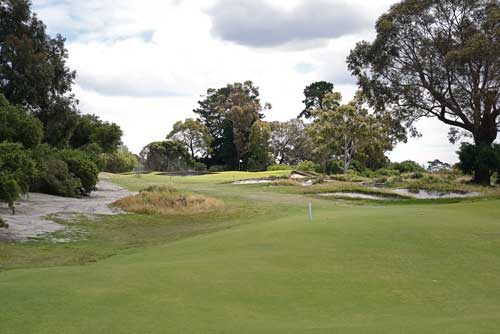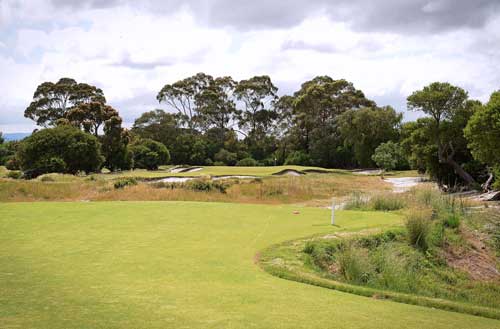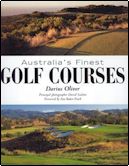KINGSTON HEATH GOLF CLUB - EXCLUSIVE REVIEW
by Darius Oliver, from Australia's Finest Golf Courses

Kingston Heath Golf Club
Course Opened – 1925
Designer – Dan Soutar, Dr. Alister Mackenzie
right - Probably Australia's best par three, the brilliant 15th at Kingston Heath
Shortly after the first World War prominent Melbourne solicitor Stanley Dutton Green led a committee of members from the Elsternwick Golf Club in a search to acquire sufficient land within the Melbourne Sandbelt to construct their own championship golf course. The search for the ideal site brought them south to Cheltenham and a small gently undulating parcel of land with a perfect sandy soil and a number of excellent natural features.

Fascinated by British design, Green had corresponded with two of golf’s biggest names, Open champions J.H Taylor and Harry Vardon, who convinced him that with the advent of the rubber-cored ball, the new course should be built of a length to ‘stand the test of time’. The committee agreed and called in Sydney professional Dan Soutar to design the layout.
Left - The par 3 5th
Soutar walked the property twice without comment before coming to rest amidst dense scrub near the centre of the site and declaring ‘here is where we start, an ideal ready made short hole for the 10th.’ He later famously changed the direction of the 10th hole, but continued to plan the entire course from this point.
When the course was ready for play in 1925, it had met the clubs’ brief and was officially the longest ever seen in Australia. Measuring a little over 6,200 metres its bogey (par) of 82 included twelve par fives and just two par threes. Golfers who today lament trends toward the 7,000 metre course should be thankful they were not around to tackle ‘the Heath’ in its infancy armed with a hickory shafted Brassie and Niblick.
Royal Melbourne had kindly offered the services of its head Greenkeeper Mick Morcom to assist with the building of fairways, tees and greens while the bunkering was deferred on news of the imminent arrival of famed architect Dr Alister MacKenzie. In town to design Royal Melbourne West, MacKenzie also advised on the bunkering at several courses within the sandbelt, leaving his most significant mark on Kingston Heath.
After one inspection of the site he enthused that ‘never yet have I advised upon a course where, owing to the excellence of design and construction work, the problems have been so simple’. Despite some reservations about its length, he clearly thought highly of Soutar’s routing while the construction had impressed him to the point of proclaiming Morcom the best he had ever encountered at his craft.
Aside from providing detailed reports on the bunkering of each hole, MacKenzie also felt compelled to suggest one important change to the overall course design, converting the blind par four 15th hole into an ingenious uphill par three. Often criticised for being obstinate, the fact he could find just one design fault was in itself a glowing endorsement of the Soutar layout.
It is interesting to note that the designer was paid 25 pounds for his tireless work while the club reluctantly paid MacKenzie ten times that amount for bunkering plans which he finished in a matter of days. Though seemingly inequitable, the club was left with one of the country’s truly great par threes and possibly the best bunkering system in the world. Today it must feel like the best 250 pounds they ever spent.

Above - the impressive Kingston Heath Clubhouse
With the exception of dense tea-tree and heavy undergrowth that was badly burnt out following a major wild fire in 1944, the natural process of the courses’ evolution has gone relatively smoothly. Recent years have seen the club look to combat problems associated with overplanting by removing a series of old Mahogany Gum’s and Cypresses and instead focusing on restoring the vast areas of low growing Heath grasses that give the course its unique character. The balance between the stands of trees and open areas of native grasses is important to Kingston Heath as part of its charm is the manner in which the holes and hazards seamlessly integrate into the surrounding vegetation.
Most of the modern course alterations were made by long time superintendent Graeme Grant, including the rebuilding of several greens, and the successful addition of a deep depression protecting the front of the reachable par five 7th. There was also the controversial placement of a new bunker in the centre of the 11th fairway prior to an Australian Open, which has been less well received. The putting surfaces, especially those Grant reshaped during his tenure, are superb and it would be hard to argue that the greens on any classic course in Australia, other than perhaps Royal Melbourne, are better than ‘the Heath’s’.
The course also boasts an astonishing collection of par threes, the signature 15th coupled with beautifully shaped and bunkered short holes at 5 and 10. Of the remaining holes, aside from a number of fascinating blind and semi blind shots, the highlight is the driveable but deadly par four 3rd. Contoured to reward only the most precise pitch shot, this outstanding green is angled across the fairway and surrounded by exquisite bunkering.
Though Kingston Heath no longer plays like the monster it once was, the combination of an ageless design and stupendous bunkering has made holes like 3, 9, 10 and 15 technology proof and helped the course stand the ultimate test of time. Its greatest defence from low scoring remains a strategic layout that is playable to all yet demands absolute precision from the professional wanting to score birdies.
Enjoying a reputation as one of the world’s finest tracks, Kingston Heath remains a supreme test of your golfing smarts. The course is a special privilege to play and one of the finest examples of golf course architecture from any era.
 This review features in Australia's Finest Golf Courses (RRP $49.95).
This review features in Australia's Finest Golf Courses (RRP $49.95).
For more details on the book click here.
Green Fee access - Access to this private club is restricted to members, guests of members and Golf Club Members from Interstate and Overseas upon payment of the applicable green fee. ausgolf can advise about playing this course, or provide additional travel advice, so please e-mail travel@ausgolf.com.au

